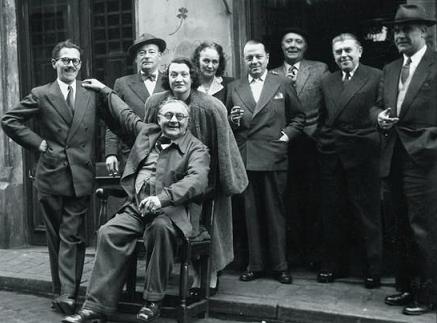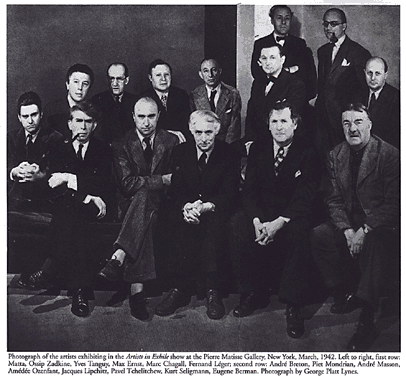
Synopsis
The Surrealist movement was founded in Paris 1924 by a small group of writers and artists who sought to channel the unconscious as a means to unlock the power of the imagination. Disdaining rationalism and literary realism, and powerfully influenced by Freud, the Surrealists believed the conscious mind repressed the power of the imagination, weighting it down with taboos. Influenced also by Marx, they hoped that the psyche had the power to reveal the contradictions in the everyday world and spur on revolution. Their emphasis on the power of the imagination puts them in the tradition of Romanticism, but unlike their forbears, they believed that revelations could be found on the street and in everyday life. The Surrealist impulse to tap the subconscious mind, and their interests in myth and primitivism, went on to shape the Abstract Expressionists, and they remain influential today. Key Ideas / Information
- Surrealism has come to be seen as the most influential movement in twentieth century art. Figures like Salvador Dalí and Man Ray not only had an important influence on avant-garde art, but through their commercial work - in fashion photography, advertising and film - they brought the style to a huge popular audience. Following the demise of Minimalism in the 1960s, the movement's influence also returned to art, and since the 1970s it has attracted considerable attention from art historians.
- Surrealism was officially founded in 1924, when André Breton wrote Le Manifeste du Surréalisme. In it, he defined Surrealism as "Psychic automatism in its pure state, by which one proposes to express - verbally, by means of the written word, or in any other manner - the actual functioning of thought." In this, he proposed that artists should seek access to their unconscious mind in order to make art inspired by this realm.
- Initially a literary movement, many Surrealists were ambivalent about the possibilities of painting, however, the group's leader, André Breton, later embraced and promoted painting. The work of Surrealist painters such as Joan Miró would be an important influence on the Abstract Expressionists in the 1940s.
DETAILED VIEW:
Beginnings
Though the Surrealist movement was officially founded in 1924, the term was first coined in 1917, when Guillaume Apollinaire used it in program notes for the ballet Parade, written by Pablo Picasso, Leonide Massine, Jean Cocteau, and Eric Satie. It began as a literary group strongly allied to the Dada movement, and emerged in the wake of the collapse of the group in Paris, when André Breton's eagerness to bring purpose to the group clashed with Tristan Tzara's anti-authoritarianism. Breton - who is occasionally described as the 'Pope' of Surrealism - would go on to be the most important figure in the movement, the impresario whose strong leadership gave it cohesion through its many reincarnations until his death in 1966. Concepts and Styles
 Surrealism shared much of the anti-rationalism of Dada, the movement out of which it grew. However, Breton, who was a part of the Dada group, wanted to form a movement in which artists could unite to protest war by accessing subconscious thoughts. The original Parisian Surrealists organized group activities as a reprieve from violent political situations and to address the unease they felt about the world's uncertainties. Surrealists were interested in exposing the complex and repressed inner worlds of sexuality, desire, and violence, and interest in these topics fostered transgressive behavior. Many of the artists underwent psychoanalysis to study and uproot their latent feelings and behaviors as a cure for what they believed to be the constraining and repressed codes and morals of society.
Surrealism shared much of the anti-rationalism of Dada, the movement out of which it grew. However, Breton, who was a part of the Dada group, wanted to form a movement in which artists could unite to protest war by accessing subconscious thoughts. The original Parisian Surrealists organized group activities as a reprieve from violent political situations and to address the unease they felt about the world's uncertainties. Surrealists were interested in exposing the complex and repressed inner worlds of sexuality, desire, and violence, and interest in these topics fostered transgressive behavior. Many of the artists underwent psychoanalysis to study and uproot their latent feelings and behaviors as a cure for what they believed to be the constraining and repressed codes and morals of society. The Surrealists generated creative works that exposed the artists' inner minds in bizarre, symbolic ways in order to uncover anxieties and to treat them analytically through visual means. The Surrealists depicted dream imagery and archetypal symbols derived from their unconsciousness. The collage aesthetic was significant to the Surrealists, as they believed it tapped into the subconscious by creating unlikely juxtapositions using imagery garnered from popular culture. The Surrealists employed collage in every medium including film.
Rise and Decline of Surrealism
 Though Surrealism originated in France, strains of it can be identified in art throughout the world. Particularly in the 1930s and 1940s, many artists were swept into its orbit as increasing political upheaval and a second global war encouraged fears that human civilization was in a state of crisis and collapse. The emigration of many Surrealists to the US during WWII spread their ideas further. However, following the war, the group's ideas were challenged by the rise of Existentialism. And in the arts, the Abstract Expressionists usurped their dominance by pioneering new techniques for representing the unconscious. Breton became increasingly interested in revolutionary political activism as the movement's primary goal. The result was the dispersal of the original movement into smaller factions of artists. The Bretonians, such as Robert Matta, believed that art was inherently political. Others, like Yves Tanguy, Max Ernst, and Dorothea Tanning, remained in America to separate from Breton. Salvador Dalí, likewise, retreated to Spain, believing in the centrality of the individual in art.
Though Surrealism originated in France, strains of it can be identified in art throughout the world. Particularly in the 1930s and 1940s, many artists were swept into its orbit as increasing political upheaval and a second global war encouraged fears that human civilization was in a state of crisis and collapse. The emigration of many Surrealists to the US during WWII spread their ideas further. However, following the war, the group's ideas were challenged by the rise of Existentialism. And in the arts, the Abstract Expressionists usurped their dominance by pioneering new techniques for representing the unconscious. Breton became increasingly interested in revolutionary political activism as the movement's primary goal. The result was the dispersal of the original movement into smaller factions of artists. The Bretonians, such as Robert Matta, believed that art was inherently political. Others, like Yves Tanguy, Max Ernst, and Dorothea Tanning, remained in America to separate from Breton. Salvador Dalí, likewise, retreated to Spain, believing in the centrality of the individual in art. Further Developments:
Abstract Expressionism
In 1936, the Museum of Modern Art in New York staged an exhibition entitled Fantastic Art, Dada, Surrealism, and many American artists were powerfully impressed by it. Some, such as Jackson Pollock, began to experiment with automatism, and with imagery which seemed to derive from the unconscious - experiments which would later lead to his 'drip' paintings. Robert Motherwell, similarly, is said to have been "stuck between the two worlds" of abstraction and automatism. New York quickly stole the focus from Paris as the emergent center of a new vanguard, one that favored tapping the unconscious through abstraction as opposed to the "hand-painted dreams" of Salvador Dalí. Peggy Guggenheim's 1942 exhibition of Surrealist-influenced artists (Rothko, Gottlieb, Motherwell, Baziotes, Hofmann, Still, and Pollock) alongside European artists Miró, Klee, and Masson, underscores the speed with which Surrealist concepts spread through the New York art community.
Feminism and Women Surrealists
The Surrealists have often been depicted as a tightly knit group of men, and their art often envisioned women as wild 'others' to the cultured, rational world. Work by feminist art historians has since corrected this impression, not only highlighting the number of women Surrealists who were active in the group, particularly in the 1930s, but also analyzing the gender stereotypes at work in much Surrealist art. Feminist art critics, such as Dawn Ades, Mary Ann Caws, and Whitney Chadwick, have devoted several books and exhibitions to this subject. While most of the male Surrealists, especially Hans Bellmer, Man Ray, and Salvador Dalí, repeatedly distorted the female form, and depicted women as muses, much in the way that male artists had for centuries, female Surrealists such as Claude Cahun, Unica Zurn, Lee Miller, Leonora Carrington, and Dorothea Tanning, sought to address the problematic adoption of psychoanalysis that often cast women as somehow monstrous. Thus, many female Surrealists experimented with cross-dressing and depicted themselves as animals or mythic creatures.
Quotes
"Poetry must be made by all. Not by one." - Isidore Ducasse, aka Comte de Lautreamont
"Contrary to prevalent misdefinitions, surrealism is not an aesthetic doctrine, nor a philosophical system, nor a mere literary or artistic school. It is an unrelenting revolt against a civilization that reduces all human aspirations to market values, religious impostures, universal boredom and misery."
- Franklin Rosemont, from André Breton and the First Principles of Surrealism
"Putting psychic life in the service of revolutionary politics, Surrealism publicly challenged vanguard modernism's insistence on 'art for art's sake.' But Surrealism also battled the social institutions - church, state, and family - that regulate the place of women within patriarchy. In offering some women their first locus for artistic and social resistance, it became the first modernist movement in which a group of women could explore female subjectivity and give form (however tentatively) to a feminine imaginary."
-Whitney Chadwick, from Women, Surrealism, and Self-Representation
"[the contribution was in their determination] to tap the creative and imaginative forces of the mind at their source in the unconcious and, through the increase in self-knowledge achieved by confronting people by their real nature, to change society"
-Simon Wilson, from preface to Dali exhibition at Tate Gallery, London, 1980


